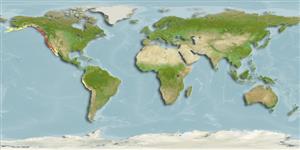Elasmobranchii (sharks and rays) >
Carcharhiniformes (Ground sharks) >
Scyliorhinidae (Cat sharks)
Etymology: Apristurus: Greek, a = without + Greek, pristis = saw + Greek, oura = tail (Ref. 45335); brunneus: From the latin 'brunneus' meaning brown (Ref. 6885).
Environment / Climate / Range
Ecology
Marine; demersal; depth range 33 - 1306 m (Ref. 96339). Subtropical, preferred ?; 60°N - 18°S, 167°E - 71°W (Ref. 56871)
Eastern Pacific: British Columbia, Canada to northern Baja California, Mexico. Probably south to Panama, Ecuador, and Peru.
Size / Weight / Age
Maturity: Lm ? range ? - ? cm
Max length : 69.0 cm TL male/unsexed; (Ref. 96339)
Short description
Morphology | Morphometrics
Inhabits the outer continental shelf and upper slope (Ref. 244). Found over muddy or sandy bottoms (Ref. 27436). Feeds on small true shrimps, euphausiid shrimps, squids, and small fishes (Ref. 244). Oviparous (Ref. 50449).
Life cycle and mating behavior
Maturity | Reproduction | Spawning | Eggs | Fecundity | Larvae
Oviparous, with a single egg per oviduct (Ref. 244). Eggs are enclosed in oblong transparent cases with tendrils at each end (Ref. 6885). Embryos feed solely on yolk (Ref. 50449). In Canada, females carry egg cases from February to August (Ref. 244).
Compagno, L.J.V., 1984. FAO Species Catalogue. Vol. 4. Sharks of the world. An annotated and illustrated catalogue of shark species known to date. Part 2 - Carcharhiniformes. FAO Fish. Synop. 125(4/2):251-655. Rome: FAO. (Ref. 244)
IUCN Red List Status (Ref. 115185)
CITES (Ref. 94142)
Not Evaluated
Threat to humans
Harmless
Human uses
Fisheries: of no interest
More information
Age/SizeGrowthLength-weightLength-lengthLength-frequenciesMorphometricsMorphologyLarvaeLarval dynamicsRecruitmentAbundance
ReferencesAquacultureAquaculture profileStrainsGeneticsAllele frequenciesHeritabilityDiseasesProcessingMass conversion
Tools
Special reports
Download XML
Internet sources
Estimates of some properties based on models
Phylogenetic diversity index (Ref.
82805): PD
50 = 0.5000 [Uniqueness, from 0.5 = low to 2.0 = high].
Bayesian length-weight: a=0.00324 (0.00157 - 0.00666), b=3.11 (2.93 - 3.29), in cm Total Length, based on LWR estimates for this (Sub)family-body shape (Ref.
93245).
Trophic Level (Ref.
69278): 3.6 ±0.0 se; Based on diet studies.
Resilience (Ref.
69278): Very Low, minimum population doubling time more than 14 years (Fec assumed to be <10).
Vulnerability (Ref.
59153): Moderate to high vulnerability (52 of 100) .
